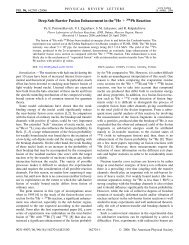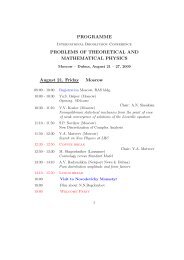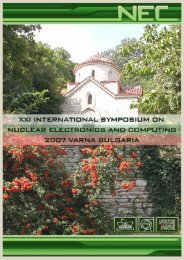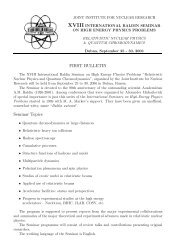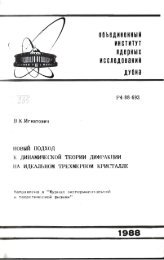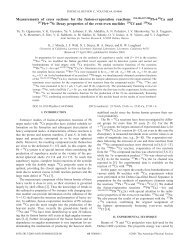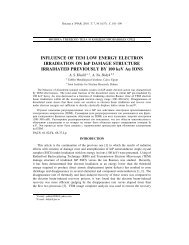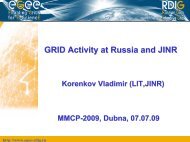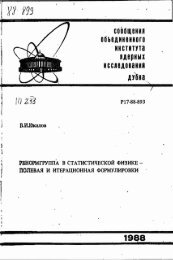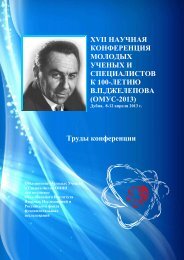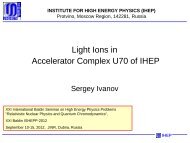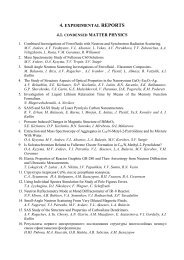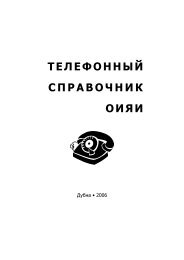Joint Institute for Nuclear Research Relativistic ... - Index of - JINR
Joint Institute for Nuclear Research Relativistic ... - Index of - JINR
Joint Institute for Nuclear Research Relativistic ... - Index of - JINR
You also want an ePaper? Increase the reach of your titles
YUMPU automatically turns print PDFs into web optimized ePapers that Google loves.
from the observation, in which the primary Nöther current operator, being between the<br />
physical (clothed) states |Ψ N 〉 = b † c |Ω〉, yields the usual on-mass-shell expression<br />
〈Ψ p,n (p ′ )|J µ (0)|Ψ p,n (p)〉 = F µ p,n (p′ ,p)<br />
in terms <strong>of</strong> the Dirac and Pauli nucleon <strong>for</strong>m factors. By keeping only the one-body<br />
contribution we arrive to certain <strong>of</strong>f-energy-shell extrapolation <strong>of</strong> the so-called relativistic<br />
impulse approximation (RIA) in the theory <strong>of</strong> e.m. interactions with nuclei (bound<br />
systems).<br />
Of course, the RIA results should be corrected including more complex mechanisms<br />
<strong>of</strong> e-d scattering, that are contained in<br />
∫<br />
J µ two−body = dp ′ 1dp ′ 2dp 1 dp 2 F µ MEC (p′ 1,p ′ 2;p 1 ,p 2 )b † c(p ′ 1)b † c(p ′ 1)b c (p 1 )b c (p 2 ).<br />
Analytic (approximate) expressions <strong>for</strong> the coefficients F µ MEC<br />
stem from the R-commutators<br />
(beginning with the third one) in the expansion (*), which, first, belong to the<br />
class [2.2], as in operators K I and B I , and, second, depend on even numbers <strong>of</strong> mesons<br />
involved. It requires a separate consideration aimed at finding a new family <strong>of</strong> meson<br />
exchange currents to be useful, as we hope, not only <strong>for</strong> describing the e-d scattering.<br />
At last, one should note that, as be<strong>for</strong>e (see, e.g. [4]), we prefer to handle the explicitly<br />
gauge-independent (GI) representation <strong>of</strong> photonuclear reaction amplitudes with<br />
one-proton absorption or emission [5]. This representation is an extension <strong>of</strong> the Siegert<br />
theorem, in which, the amplitude <strong>of</strong> interest is expressed through the Fourier trans<strong>for</strong>ms<br />
<strong>of</strong> electric (magnetic) field strengths and the generalized electric D(q) (magnetic M(q))<br />
dipole moments <strong>of</strong> hadronic system. It allows us to retain the GI in the course <strong>of</strong> inevitably<br />
approximate calculations. It has turned out that the Cartesian electric (magnetic)<br />
moments <strong>of</strong> the distribution J 0 (x) (J(x)) can be deduced from the MacLaurin<br />
series, respectively, <strong>of</strong> the longitudinal projection q ·D(q) and the function M(q) itself<br />
in the vicinity <strong>of</strong> the point q = 0. In particular, we find the following <strong>for</strong>mula<br />
µ d = 1 [ ] z|<br />
〈⃗0;M ′ = 1| ⃗B × J(0) ⃗ ⃗0;M = 1〉<br />
2m d<br />
<strong>for</strong> the magnetic moment <strong>of</strong> the deuteron. Of course, we could present details <strong>of</strong> our calculations<br />
to compare them with the available ones and show the corresponding numerical<br />
results.<br />
References<br />
[1] A. Shebeko, P. Frolov and I. Dubovyk, Proc. <strong>of</strong> the XX Intern. Baldin Seminar on<br />
High Energy Physics Problems (Dubna, Russia, 2010) V. I pp. 75-81.<br />
[2] A.V. Shebeko, Chapter 1 in: Advances in Quantum Field Theory, ed. S. Ketov, 2012<br />
InTech, pp. 3-30.<br />
[3] I. Dubovyk and A. Shebeko, Few Body Syst. 48 109 (2010).<br />
[4] L. Levchuk, L. Canton and A. Shebeko, Eur. Phys. J. A 21 29 (2004).<br />
[5] L. Levchuk and A. Shebeko, Phys. At. Nucl. 56 227 (1993).<br />
115



